Gear calculation online – super easy!
- Details
- Hits: 22518
GWJ Technology offers software for the Gearcalculation im Transmission and mechanical engineering. The calculation professional from Braunschweig supports design and development engineers in their daily work. Here you will find further developments of the web-based calculation software eAssistant and the transmission software TBK. Recent additions are a Module for the Hirth toothing and a CAD functionality that supports the Export of gears supported in 3D STEP or Iges format.

Contents
- Calculate Hirth teeth online
- Gear calculation for 3D gears in step format
- Extended spur gear calculation
- Calculate plastic gears online in detail
- Web-based calculation software for gear drives
- Frequently asked questions
Calculate Hirth teeth online
 10.01.2022/XNUMX/XNUMX | GWJ has its web based calculation software eAssistant for design and development extended by a module for calculating Hirth gearing. With its straight, triangular teeth, the Hirth toothing or spur tooth connection is one of the shaft-hub connections.
10.01.2022/XNUMX/XNUMX | GWJ has its web based calculation software eAssistant for design and development extended by a module for calculating Hirth gearing. With its straight, triangular teeth, the Hirth toothing or spur tooth connection is one of the shaft-hub connections.
The type of toothing of this form-fitting, self-centering and easily detachable Gearit comes in Engineering for use. The technology precisely connects shafts, discs, rotors, wheels and cranks, positioning them precisely and thus transmitting high torques.
The new eAssistant module automatically calculates the Geometry of the Hirth teeth. To do this, the user enters values such as the number of teeth on the gears, outside and inside diameter, flank angle and tooth root radius. The program also supports various special cases of Hirth gearing.
In addition, the axial force, pre-tensioning force, permissible surface pressure and the corresponding safety factors are recorded directly in the Calculation module displayed in the result overview. The usual dimensions with diameters from 50 to 900 mm can be selected from an integrated database at the push of a button - each with the appropriate number of teeth, inner diameter and tooth root radius.
The permissible pressures are determined based on the material properties. Existing materials can be selected from the integrated material database. Individual materials can also be entered for the calculation.
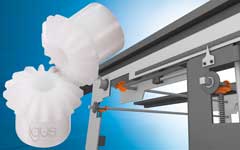 Efficient gear wheel perspectives made of high-performance plastic
Efficient gear wheel perspectives made of high-performance plastic
After the calculation has been carried out, the user receives a detailed Calculation protocol in HTML and PDF format. A 3D model of the Hirth toothing is available directly in a CAD system via the eAssistant 3D CAD plugin.
Gear calculation for 3D gears in step format
15.04.2021/XNUMX/XNUMX | With the new CAD function for gear wheel calculation in the calculation software eAssistant lets the Geometrie Generate various types of gearing as a 3D CAD model in Step and Iges format. This gives the user an alternative to the intelligent 3D CAD plugins for CAD systems such as Autodesk Inventor, SolidWorks, Solid Edge or Siemens NX.
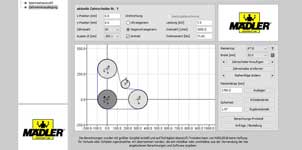 Calculate, lay out and order timing belt length online
Calculate, lay out and order timing belt length online
Step and Iges format are standardized exchange formats for 3D models. They can be used in almost anything CAD system import. In the settings menu for the output of both formats, the user can choose from various functionalities with which he can customize the export. The geometry can be generated as a volume model with one tooth, for all teeth or as a surface model of the tooth gap geometry. When exporting, the degree of accuracy can be changed from Gear can be set to a desired value.
Currently include the following Calculation modules the new Step / Iges export: Individual gear wheel outside and individual gear wheel inside for the geometry calculation of individual gear types such as straight and helical gears, pair of spur gears, planetary stages, 3rd and 4th gear chain, straight and helical bevel gears, spiral bevel gears and splined shaft connections (DIN 5480 etc.) . Alternatively, involute tooth shapes can also be output in the 2D DXF with various setting options. The tooth shape geometry of gears in face section and normal section is supported.
Extended spur gear calculation
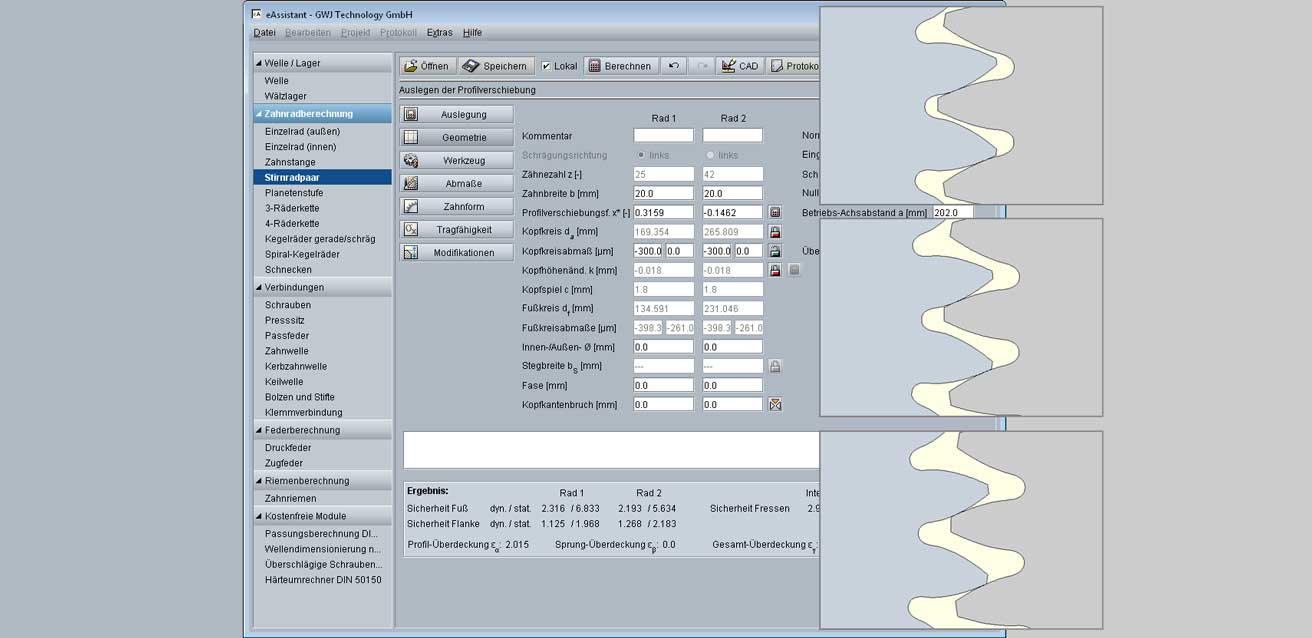
30.06.2020/XNUMX/XNUMX | GWJ has his Calculation module for spur gear pairs expanded within the web-based software eAssistant. An option for decoupling the profile shift sum and center distance has been implemented in the cylindrical gear pair calculation module. This supplements the various design functions for the distribution of the profile shift factors.
With the new function Fixed operating center distance (Recalculation) the factors for the profile shift can be specified independently of the center distance. With this, for example, existing spur gear pairs are calculated that are to be installed in the housing with the wrong center distance. Backlash, profile overlap and load-bearing capacity are precisely calculated. The function can also be used when designing small-module toothing of spur gears.
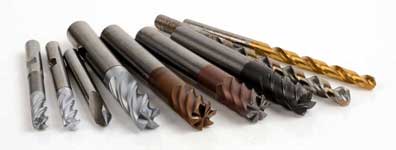 Calculate fit calculator and roughness online
Calculate fit calculator and roughness online
For tools with shifted profile reference line In addition to the head height factor haMP0 * of the moved profile, the foot height factor hfMP0 * is also displayed and output in the log. It can also be specified using a lock function so that the foot height factor hfP0 * of the converted, non-shifted reference profile according to the definition of DIN 867 is always 1,0.
Further novelties: The full radius option for the cutting wheel head shape for hobs has been added. When defining load collectives, the width factor KHbeta and the temperature can now be specified for each load case. This allows the automatic transfer of values directly from the System Manager system extension to the spur gear module in the background.
At the system level is now visible how due to flank modifications change the tooth root safety and flank safety. In addition to the load capacity calculation methods according to DIN 3990, ISO 6336 and Ansi / Agma 2101, the load capacity for plastic gears according to VDI 2736 has been implemented in the new release.
Calculate plastic gears online in detail
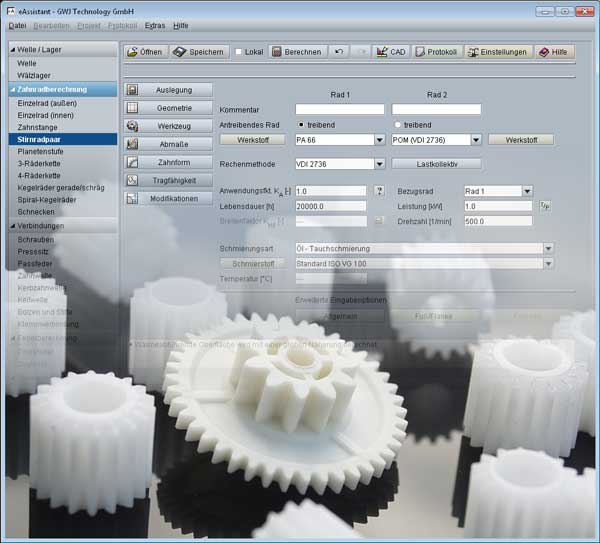 18.05.2020/XNUMX/XNUMX | GWJ Technology has expanded its web-based software eAssistant to include the possibility of Calculation of plastic gears expanded. The calculation method for plastic gears according to VDI 2736 is now available in the cylindrical gear pair module. It supplements the calculation methods for load-bearing capacity according to ISO 6336, DIN 3990 and Ansi / Agma 2101.
18.05.2020/XNUMX/XNUMX | GWJ Technology has expanded its web-based software eAssistant to include the possibility of Calculation of plastic gears expanded. The calculation method for plastic gears according to VDI 2736 is now available in the cylindrical gear pair module. It supplements the calculation methods for load-bearing capacity according to ISO 6336, DIN 3990 and Ansi / Agma 2101.
Plastics included in material database
At the same time, GWJ first plastics in general materialdatabase added. The temperature-dependent characteristic values such as fatigue strength and Young's modulus from the diagrams of VDI 2736 are now approximated and stored for them.
The data is used to deal with the after VDI 2736 automatically calculated tooth root and tooth flank temperatures to determine the associated material properties for the calculation of the load capacity. If the temperatures determined for the tooth flanks or tooth base exceed the maximum service temperatures of the corresponding plastics, a warning is given.
For the calculation of the Tooth flanks and tooth root temperatures As an alternative to an automatic pre-assignment, the design of the housing, heat dissipating surface and heat transfer as well as thermal resistance can be specified by the designer.
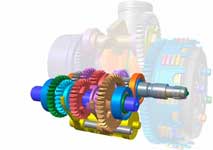 Simulation software for the behavior of the transmission and drive train
Simulation software for the behavior of the transmission and drive train
As a Material pairings We recommend pairings of plastic | Plastic and plastic | Metal. Also pairings of metal | Metal are supported for a comparison to the calculation methods for metal gears. There is a load spectrum calculation for the load capacity calculation according to VDI 2736. The dry run function has been added to the lubrication types for VDI 2736.
Web-based calculation software for gear drives
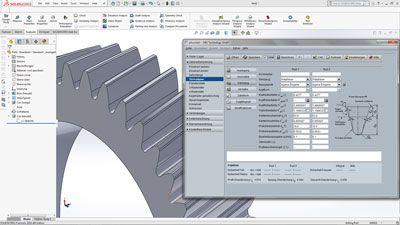 16.01.2018/XNUMX/XNUMX | GWJ Technology provides an updated version of the web-based gearbox calculation software gear transmission "Eassistant". A click on "New" closes the current calculation and opens the calculation module with the internal Eassistant default template or with the user's own default template.
16.01.2018/XNUMX/XNUMX | GWJ Technology provides an updated version of the web-based gearbox calculation software gear transmission "Eassistant". A click on "New" closes the current calculation and opens the calculation module with the internal Eassistant default template or with the user's own default template.
In addition to DIN 3961 for gearing tolerances / gearing qualities, DIN 58405 now also stands for the precision engineering as well as ISO 1328 and Ansi/Agma 2015 in the modules "Individual wheel (external / internal gearing)", "3- and 4-wheel chain" and rack and pinion are available.
The definition of the tool reference profiles in the pair of spur gears and in the single gear (outside) has been edge break flank as well as around head overlap expanded. Corresponding hobs can be specified with the definition of the chamfer flank. These produce a tip edge fracture during the rolling process. With the tip overlap option, the tip circle diameter is determined directly with the root height factor of the tool. Subsequent turning off of the tip circle diameter is therefore not possible. At the same time, the addendum circle deviations result in the same way as the root circle deviations directly from the tooth thickness deviations.
Frequently asked questions
What is a Hirth coupling?
The Hirth teeth serve the form-fitting, self-centering and easily detachable connection with a shaft, disc, rotor, etc. Its inventor is Albert Hirth. A Hirth toothing is very robust and suitable for the transmission of impact and alternating forces. In addition, it is very space-saving due to its small design. During assembly, the parts center themselves. The gearing can be produced inexpensively.
How does a gear wheel work simply explained?
A gear is one machine element, which serves to transfer power from one part of the machine to another by changing the rotary motion.
Put simply, one works gear transmission by the meshing of teeth and the transmission of torque from one Gear to another. Gears work like levers in that, depending on their size and shape, they can transfer a small force into a larger one, or vice versa. How this works depends on the type of gear used: there are bevel gears (where two shafts intersect at right angles), helical gears (with curved teeth moving along parallel axes), spur gears (straight-toothed gears with cylindrical bodies) and worm gears (meshing between two spiral elements).
In most cases, that is number of teeth between two gears unequal such that one spins faster than the other when rotating, resulting in both moving at different speeds but in the same direction. This is useful for applications like conveyor belts that need to be constantly synchronized, or variable speed mechanisms like those found in automobiles that allow for quick up and down shifts between different gear ratios without gear parts completely disengaging.
In addition, the different division allows the machines a so-called torque multiplication, which enables much higher performances than would be possible without the use of gear mechanisms.
You might also be interested in...
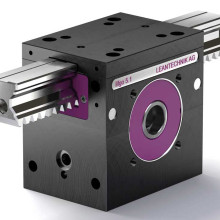
rack gear | Highly accurate for precise movements
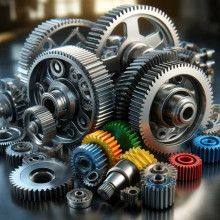
Gear | Types, manufacturer, configurator

Angela Struck is editor-in-chief of the development scout and freelance journalist as well as managing director of Presse Service Büro GbR in Ried.
